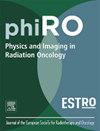Stability of liver position in a shuttle-based workflow for daily online magnetic resonance imaging-guided particle therapy
IF 3.3
Q2 ONCOLOGY
引用次数: 0
Abstract
Background and Purpose
Online adaptive particle therapy makes it possible to consider interfractional changes during treatment, and therefore may lead to improved treatment outcomes. The advantages of online adaptive particle therapy may be realized with minimal workflow disruption by employing a shuttle-based daily quasi-online magnetic resonance imaging (MRI)-guided strategy, where the patient remains in the treatment position on a transfer table for MRI at a diagnostic device and subsequent treatment delivery. This study investigated potential liver displacement and deformation while using a shuttle-based workflow.
Material and methods
Fourteen healthy volunteers each underwent four MRI scans in a 1.5 T MRI scanner, with intra-hospital transport simulations between MRI scans. The study proceeded in the following steps: volunteer positioning, first MRI scan (MRI 1), ten-minute time control phase, second MRI scan (MRI 2), short transport phase, third MRI scan (MRI 3), long transport phase, and finally the last MRI scan (MRI 4). In each MRI set, the liver and relevant external outline were contoured. Dice similarity coefficient (DSC) and mean distance to agreement (MDA) were calculated to quantify consecutive shifts between image sets and accumulative shifts over the course of the study.
Results
Median MDA values for the liver (and for the external) contour were 0.6 mm (0.4 mm) for MRI 1 – MRI 2, 0.4 mm (0.5 mm) for MRI 2 – MRI 3, and 0.3 mm (0.7 mm) for MRI 3 – MRI 4. All subjects exhibited MDA values of <1.0 mm (<1.5 mm) and DSC values of >0.97 (>0.98) during transport phases. Outliers for the accumulative shift from MRI 1 – MRI 4 remained at <2.0 mm (<1.8 mm) after approximately 75 minutes.
Conclusions
The study demonstrated the high stability of the liver position in a shuttle-based workflow, a finding that can be used to enhance MRI-guided adaptive treatment strategies in radiotherapy.
日常在线磁共振成像引导粒子治疗中基于穿梭工作流程的肝脏位置稳定性
背景和目的在线自适应粒子治疗使治疗过程中考虑分数间变化成为可能,因此可能改善治疗结果。在线自适应粒子治疗的优势可以通过采用基于班车的每日准在线磁共振成像(MRI)引导策略来实现,在此策略中,患者保持在诊断设备和后续治疗交付的转移台上的治疗位置。本研究使用基于穿梭的工作流程调查潜在的肝脏移位和变形。材料和方法14名健康志愿者每人在1.5 T MRI扫描仪中接受4次MRI扫描,并在MRI扫描之间进行院内运输模拟。研究按以下步骤进行:志愿者定位,第一次MRI扫描(MRI 1), 10分钟时间控制阶段,第二次MRI扫描(MRI 2),短传递阶段,第三次MRI扫描(MRI 3),长传递阶段,最后一次MRI扫描(MRI 4)。在每组MRI中,肝脏和相关的外部轮廓被勾画。计算骰子相似系数(DSC)和平均一致距离(MDA),以量化图像集之间的连续偏移和研究过程中的累积偏移。结果MRI 1 - MRI 2肝脏(及外部)轮廓的中位MDA值为0.6 mm (0.4 mm), MRI 2 - MRI 3为0.4 mm (0.5 mm), MRI 3 - MRI 4为0.3 mm (0.7 mm)。所有受试者在运输阶段的MDA值为<;1.0 mm (<1.5 mm), DSC值为>;0.97 (>0.98)。大约75分钟后,从MRI 1到MRI 4累积偏移的异常值保持在2.0 mm (1.8 mm)。结论:该研究表明,在基于穿梭的工作流程中,肝脏位置具有高度稳定性,这一发现可用于增强mri引导的放疗适应性治疗策略。
本文章由计算机程序翻译,如有差异,请以英文原文为准。
求助全文
约1分钟内获得全文
求助全文
来源期刊

Physics and Imaging in Radiation Oncology
Physics and Astronomy-Radiation
CiteScore
5.30
自引率
18.90%
发文量
93
审稿时长
6 weeks
 求助内容:
求助内容: 应助结果提醒方式:
应助结果提醒方式:


